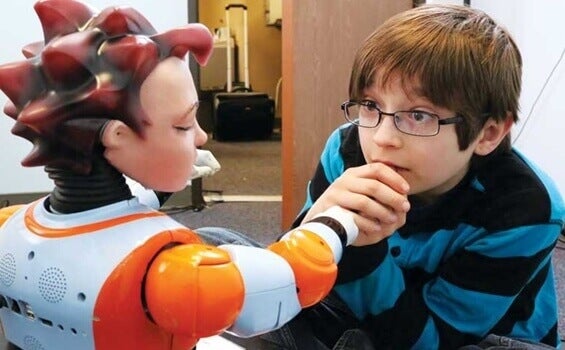Robots are progressing in such a way that many are already part of our lives (cooking robots, vacuum cleaners), on the other hand, with this gradual integration into our routine, some have already begun to take human form, in this sense. Some people may be afraid of the speed at which these automatic machines are advancing, however, the truth is that the opportunities they give us and can bring us into the future are immense, including if there are any in which they stand out. , is the aid resulting from the interaction between robots and autistic children.
Many autistic children suffer from social isolation and communication difficulties, this makes all the help we can provide difficult to convey, it is as if we are finding a barrier. However, it seems that robots are more likely to succeed.
- “These robots.
- Unlike people.
- Have simple behaviors.
- They are able to speak.
- But following simple speeches.
- Making head movements and facial expressions easily identifiable.
- -The Pas-.
The paradox is curious: many autistic children who have difficulty communicating do not present them when communicating with a robot, we are talking about simple little emotional robots, which have eyes and limbs.
These robots have given rise to what can be called ‘robotic therapy’, a new way to address patients’ problems, which in this case concerns children and people with autism, but how and why robots achieve what humans can’t?
To try to find answers, let’s learn about the story of John, a 6-year-old who at age 2 was diagnosed with autism, stopped talking and interacting with others and became increasingly ingested. developed a strong aggression that affected his loved ones.
Juan’s mother did not know who to ask for help, they had tried the recommended therapies, but nothing had worked for Juan, it seemed that instead of improving the situation it got worse, when his mother found out about the possibility of robotic therapy, she did not I doubted it. After a while, the results began to appear.
For some reason, John began to emerge from the bubble in which he had immersed himself and becoming ingrained from others, began interacting with the robot with which he was doing therapy, his mother could not contain his emotions. His son touched the robot, laughed and even repeated some words he had uttered. Definitely a victory.
Miguel Hernández University in Elche and AISoy Robotics continue to work together to create robot therapy to help children with ASD (autism spectrum disorder).
Perhaps it was possible to imagine that because John was able to interact with the robot with which he was doing therapy and not with people, he would only interact with the robot again, and this would affect his daily life, however, that was not the case. Case. All of Juan’s progress with the robot was used to interact with everything around him.
By isolation, without speaking and unrelated to others, John was unable to increase his communication capacity, thanks to therapy robots his vocabulary gradually improved and, as we have seen, emotions have also been stimulated. John was already laughing, that is, he was able to express what he felt.
Without this type of therapy, John would never have been able to escape the isolation he had entered, perhaps he could do it, but he would need more time, all we know is that this new type of therapy has produced the desired results, helping John and certainly many other children with unusual skills to communicate with others and develop social skills.
Many children with autism spectrum disorders have an impressive talent for music or painting, for example, in which they put all their creativity, this is the only type of interaction they are able to do, either with a screen or with a musical instrument. can approach a more “human” type of interaction. Robots mean that the progress of autistic children is transferred to their daily lives.
Today, there is still no cure for autism, however, researchers continue to look for new ways to encourage autistic children to progress and acquire socialization tools. Robots seem to be a great tool.

